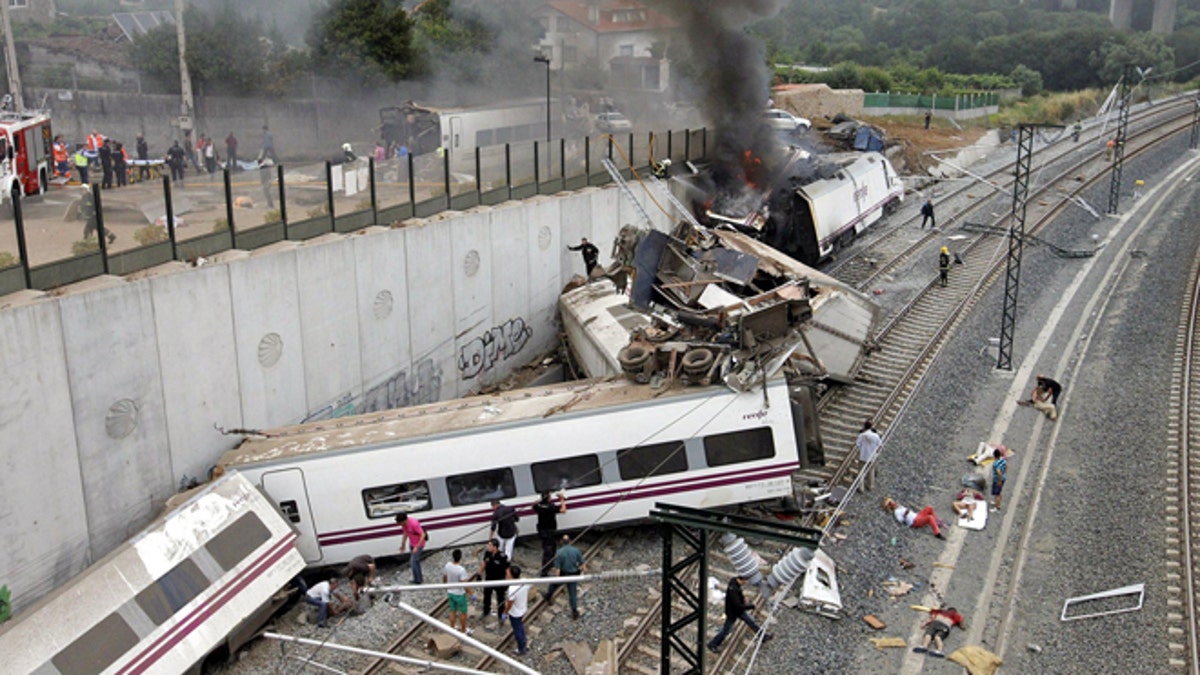
In this photo taken on Wednesday July 24 2013, Emergency personnel respond to the scene of a train derailment in Santiago de Compostela, Spain. Police say they have detained the driver of a train that crashed in northwestern Spain and killed 78 people. Galicia region National Police Chief Jaime Iglesias says driver Francisco Jose Garzon Amo was officially detained in the hospital where is recovering. (AP Photo/La Voz de Galicia/Monica Ferreiros)
Following Wednesday’s horrific train accident in northeast Spain, which left at least 78 people dead and scores more injured, there has been speculation that such a wreck could happen in the U.S. as the country continues to build high-speed rail lines through its busy transit corridors.
Transit officials and analysts alike, however, argue that such an accident wouldn’t happen in the U.S. given the regulations, separate tracks and history of safety that accompanies high-speed rail lines. With a number of high-speed trains either planned or proposed across the country, including in California, the Northeast corridor between Washington and Boston, and in the Midwest around Chicago, high-speed rail advocates are quick to distance Spain’s tragedy from their vision of widespread rail lines across the U.S.
“It was an older regional rail line that was not formatted for the high-speed lines,” Andy Kunz, the president of the U.S. High-Speed Rail Association told Fox News Latino of the train involved in Spain’s accident. “If you look at the video, the train was traveling over 100 miles an hour around that curve when it was only supposed to go about 50.”
An American passenger injured on the train said he saw on a TV monitor screen inside his car that the train was traveling 194 kph (121 mph) seconds before the crash — far above the 80 kph (50 mph) speed limit on the curve where it derailed, according to an interview conducted by The Associated Press.
The train’s conductor has been detained by Spanish authorities and there is an investigation into possible failings by the 52-year-old conductor and the train's internal speed regulation systems.
The railway defended the driver on Friday, saying he had an "exhaustive" understanding of the rail line.
Spain's Renfe rail company said conductor Garzón Amo has been with the company for 30 years; he became an assistant conductor in 2000 and a fully qualified one in 2003. He had purportedly taken the train past the same spot of the accident many times before without incident.
Officials from Amtrak, the U.S. publicly funded train service that runs the Acela train line between Washington and Boston that reaches a maximum speed of 150mph, pointed out that the company’s trains are only permitted to reach high speeds in specific sections and that there are electronic stoppers that slow a train down near dangerous bends in the track.
“On the Amtrak-owned sections of the Northeast Corridor between Washington and Boston, the signal system is designed to automatically enforce a speed reduction on a curve,” Cliff Cole, Amtrak’s media relations manager in New York said in an email to Fox News Latino. “When approaching a curve where speed reduction is critical, the train control system will automatically apply the brakes in the unlikely event that a locomotive engineer fails to do so.”
Other experts said that other countries where high-speed lines have been operating for decades have never had a deadly incident and those recent train accidents in the U.S., such as the 2012 derailment in New Jersey that led to a chemical spill, were due to old equipment or rails. Japan has operated its own high-speed rail line for 50 years and carried over 9 billion people without incident. France has done so almost since the 1980s, Kunz said.
He added that accidents like Spain’s will do little to deter the development of new rail lines in the U.S. as the high-speed rail safety record is increasingly better than plane or automobiles, and people will be more likely to travel by train as the price of oil continues to rise.
“It’s going to be a big change,” Kunz said. “But with the rising fuel prices and congestion on roadways this will soon be the only form of transportation that is clean, inexpensive and efficient.”
